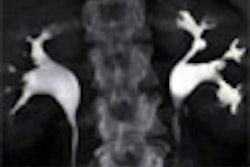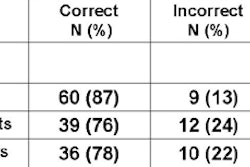A meta-analysis of virtual colonoscopy studies has enumerated what radiologists have been noticing for years: that VC reveals important incidental abnormalities. The findings deemed "important" ranged from abdominal aortic aneurysms (AAA) to early extracolonic cancers -- the latter detected at rates statistically equivalent to that of breast cancer screening. The authors, from the University of Birmingham and St. Mark's Hospital in London, could only conclude that VC may become an important method of detecting early extracolonic cancers.
"A holistic assessment of the benefits and drawbacks of colonography, as compared with other diagnostic and screening methods, must include an assessment of the benefits and harms which result from the detection of these lesions," cautioned authors Tengbin Xiong, Matthew Richardson, Rebecca Woodroffe, Dr. Steve Halligan, Dion Morton, and Richard Lilford, Ph.D., in The British Journal of Radiology. "A rational assessment of the 'balance sheet,' contingent on finding these incidental lesions, must begin with careful enumeration of the frequency and nature of such lesions," (BJR, January 2005, Vol. 78:925, pp. 22-29).
To that end, the authors searched for reports of VC incidental findings in clinical studies and electronic databases, as well as the results of a tally of nonjournal-reviewed literature categorized separately as peer scrutiny was presumed to be less rigorous in meeting abstracts.
They examined whether the studies were prospective or retrospective, consecutive or not, and whether the tests were for diagnostic or screening purposes. The researchers tallied reports of incidental lesions, and noted whether they were deemed "important" by the authors. Full peer-reviewed articles (n = 14) and conference proceedings based on abstracts (n = 4) were separated into tables 2 and 3, respectively. Studies of populations, such as the elderly who did not undergo cathartic cleansing, were gathered under table 4.
Of the most rigorous group of 13 peer-reviewed studies, only six stated clearly that the cohort was consecutive. Among all the studies, 3/17 were for screening while 14/17 were diagnostic. Studies with overlapping cohorts were eliminated as well. For example, studies led by Dr. Joel Fletcher and Dr. Amy Hara of the Mayo Clinic in Rochester, MN, had some of the same patients, so Hara's study was removed from consideration, the authors noted. The mean subject age, in the mid-60s in most studies, was considerably higher in the frail elderly.
"The number of abnormalities was high in all three series (peer-reviewed, conference abstracts, and frail elderly)" the authors wrote. "In total 40% (1,314/3,280) of patients were recorded to have abnormalities. The percentage of people with an abnormality was 36% (930/2,565), 65% (316/483), and 29% (68/232) in the three series, respectively. The total number of abnormalities was even greater, since many patients had more than one abnormality. The total number of abnormalities as a proportion of people screened was 58% (1,483/2,565), 66% (190/290), and 26% (90/350), respectively, in the three series," with calculations based only on those studies that provided the numerator and denominator information, the group noted.
Authors deemed certain findings "important" depending on clinical relevance, or the need for further investigation, and the U.K. authors tallied these as well. The total number of findings deemed "important" under such varying criteria was 292 among 2,787 patients, or 10.5%. Separating out the commonest named diseases yielded lower numbers still, including proven extracolonic cancers (81/3005, 2.7%) or abdominal aortic aneurysms (30/3,305, 0.9%).
Immediate treatment for various emergent findings was given in 17/2,237 (0.8%) cases. Among two studies that measured long-term follow-up, the probability of detecting an additional lesion was 2.7%, the authors wrote.
Among six studies that recorded the size of AAA, three such findings (19%) were larger than 5.5 cm in size, and the remainder ranged from 3-5.5 cm, Xiong and colleagues noted. Based again on the studies with complete information, 0.9% (24/2,549) patients had early stage N0M0 cancers, including six kidney cancers, five ovarian cancers, five lung cancers, four pancreatic cancers, and one liver cancer, all seen in higher incidences than reported in the Surveillance, Epidemiology, and End Results (SEER) database.
"The number of further investigations carried out was also quite large -- in some cases it exceeded the number of lesions regarded as important by the author," the group wrote. "A total of 13.8% (188/1,362) of patients had further investigation."
Search for meaning
Two noteworthy results of the study were the high incidence of total findings (in 58% of patients) and the large number of patients (13.8%) requiring further investigation. But follow-up yielded a low rate of serious disease, the authors noted. Only 0.8% of patients needed immediate treatment, and only 3.7% had cancer or an aneurysm.
Nevertheless, they stated, "a detection rate for 'early' cancer of about 6 per 1,000 is significant in both clinical and epidemiological concerns," Xiong and colleagues wrote. "For example, the prevalence of "early" colorectal cancer in breast screening programs is similar (range from 5.6 to 8.5 per 1,000 women), and the prevalence of ovarian cancer in ovarian cancer screening programs range was very much lower (about 1 per 2,000 women). Indeed, the prevalence of 'early' colorectal cancer detected by this modality in screening studies is of similar magnitude (0.7% had N0M0 bowel cancer). It therefore transpires that colonography may be an important method for the detection of early cancers other than colon cancers, although we recognize that this modality also detects colonic lesions in their premalignant phase."
In all, 42% of the cancers were early stage, and although the data would tentatively suggest that screening could be beneficial, "very long sojourn times suggest that the number of years of life gained might be quite modest," they wrote. Future modeling based on larger studies such as the U.S. Prostate, Lung, Colorectal and Ovarian (PLCO) trial will be needed to adequately assess the potential and the costs.
Finally, the group observed, these are still the early days of VC screening, and the findings reported by many researchers still lack the level of detail that will be needed to adequately assess the benefits of screening.
By Eric Barnes
AuntMinnie.com staff writer
March 23, 2005
Related Reading
Diagnostic, screening VC comparable in extracolonic disease detection, December 6, 2004
Virtual colonoscopy picks up flat lesions, November 15, 2004
Even low-dose VC yields extracolonic findings, September 21, 2004
What virtual colonoscopy misses might not matter, August 18, 2004
Workflow issues key in virtual colonoscopy, January 15, 2003
In VC, extracolonic findings offer valuable information at little extra cost, June 3, 2002
Copyright © 2005 AuntMinnie.com




















